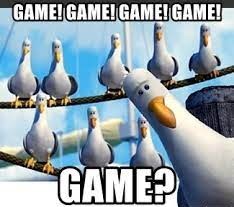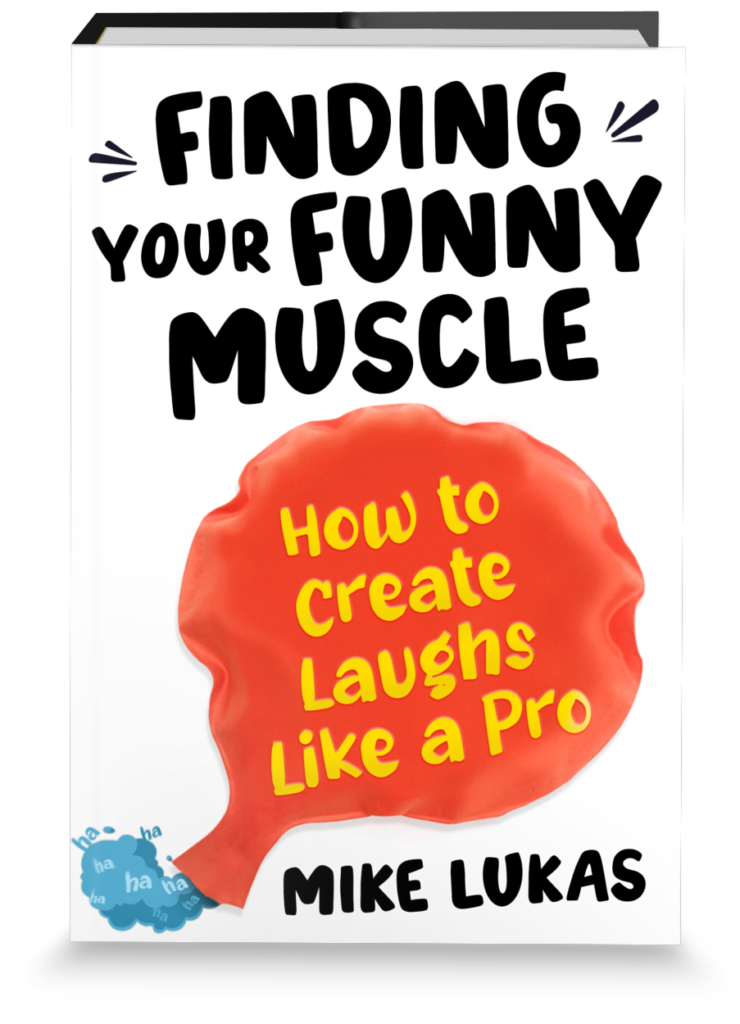Figuring out why a joke didn’t work and trying again is what makes you funnier.
This Amazon bestseller teaches you how to create laughs like a pro.
I tell you, we are here on Earth to fart around, and don't let anyone tell you different..
- Kurt Vonnegut
Hey there!
Welcome back to the Thinkin’ Funny Blog where it’s my goal to help serious people start thinkin’ funnier.
My name is Mike Lukas. For almost two-and-a-half decades I made a comfortable living making audiences laugh until they soiled furniture. In the late nineties and early 2000’s, I was a touring comedian with multiple national TV spots as well as an improvisor with the Second City Theater in Chicago and Las Vegas.
During that time, I learned three key Thinkin’ Funny tactics that helped fine-tune my humor.
These strategies opened my mind to all the creative possibilities I’d been overlooking as a civilian.
This trio of ‘secret weapons’ unlocked my creative and humorous potential as a comedian and improvisor, and they still do as a writer today.


Whoa, relax Willy-Gene and blond-toddler-Dratch, I’ll share ‘em with you right now.
Thinkin’ Funny Secret Weapon #1: Yes-And-ing
The first creative ‘secret weapon’ I learned was the idea of “Yes-And-ing.”
Good improvisation involves the acceptance of the contributions added by others.
With every idea I hear, using this strategy I never say, “But…” or “No, how about…” or “That’s weird…”
When I begin to “yes-and,” I not only agree with that person’s idea, but then I also take it one fun step further.
This heightens what’s being talked about and helps me to find the ‘game’ of the scene, which we’ll talk more about later in this post.
My improv instructors knew all this, of course, so they had us practice yes-and-ing until “accepting and expanding” became muscle memory to us.
When ‘yes-and-ing’ becomes second nature, so does Thinkin’ Funny. That’s because suddenly new ideas start going somewhere instead of fizzling out the way they tend to do with disagreement.
For instance, say you’re at the grocery store and some lady in the fruit aisle says, “These watermelons sure look ripe.”
Perfect chance to start Thinkin’ Funny.
The potentially funny moment would go nowhere if you responded with, “Actually, ma’am those are televisions.”
Or, “What do you mean, you idiot, those are rotten as hell.”
You might get a cheap laugh from the shelf-stocker, but then what?
Through disagreement, the moment devolves into two people battling for separate realities. Then the potential for creating something fun together is lost.
On the other hand, when someone says, “These watermelons sure look ripe…”
A Yes-And-er might respond, “Dang right they’re ripe, lady. Now let’s fill ‘em up with this grain alcohol.”
Or, “Good eye, ma’am. I’d like to invite you to join the Fresh Fruit Spotters Club I’m forming.”
Or, if you’re a sexist pig, “Those aren’t the only ripe melons I see, lady.”
Three totally different funny moments, each with lots of potential, including a well-deserved slap in the face with the last one.
That’s because Yes-and-ing sparks original choices and heightens them through mutual agreement.
Plus it prevents the downward creative spiral that typically follows the disagreement that comes from No-But-ing.
Which brings us straight to…
Thinkin’ Funny Secret Weapon #2: Find and heighten the ‘game’
The second key creative concept I learned as a funny-man was how to find and heighten the “game” of the scene.

By definition, a scene’s game is “a repeated pattern of funny behavior with escalating emotion.”
The simplest example of ‘the game’ is when Bob’s good buddies get together and start busting Bob’s balls for saying something dumb. The game becomes “How dumb is Bob?” and everybody takes a turn.
Bob is so dumb he has to strip naked to count to 21.
…it takes him an hour and a half to watch 60 Minutes.
…he took an IQ test and got a letter grade.
Classic game, classic jokes, classic Bob.
It’s the same thing in an improv scene.
As the scene begins, the actors find a funny thing happening and they turn it into a game by taking turns exploring and heightening it.
We do this by yes-and-ing what the others brought to the game, taking it to newer and higher levels using a group mind.
Another basic example of finding the game might involve that guy who was filling his ripe watermelons with grain alcohol earlier.
One game that might evolve in that funny conversation is we discover he’s a functioning alcoholic who fills other ripe items in his world with grain alcohol – the fresh tuna fish sandwich in his lunch, his new hat, his new tense employee, his crying infant son…
Another game, albeit a touchy one, could involve that rude, sexist pig at the grocery store who noticed that lady’s “ripe melons.”
The game becomes: attractive body parts = delicious foods.
Her fresh cucumber legs, her tender macaroni lips, those newly baked buns…you get the idea.
And that guy’s getting slapped again.
When the game is afoot and played well, it typically heightens into places previously unknown. That often unlocks some unique ideas and scenarios that can be gloriously humorous or dark or dramatic (or in the best of cases, all the above).
Finally comes the third secret weapon that often gets the funny ball rolling.
Thinkin’ Funny Secret Weapon #3: What-If-ing
The third key principle I learned as a comedian is a simple way to unleash my creative muse at will. I was taught to do this by always asking, “What if…?” about the normal parts of my world.

Without actually saying the words, Morpheus demonstrates the power of asking “What if?” in the movie The Matrix.
“Have you ever had a dream, Neo, that you seemed so sure it was real? But if you were unable to wake up from that dream, how would you tell the difference between the dream world and the real world?“
By asking (or in Morpheus’s case, implying) “What if?” it forces us to look at common things we may take for granted and twist them in a unique way that shakes up that normalcy big time.
In another example, say I’m standing in a long line at the bank.
Bored, I start playing “What If?”
What if one of the people waiting in line was wearing a ski mask?
Or, what if one of the tellers is dying to be a famous actress?
Or, what if instead of money, this bank dealt in clam chowder and seashells?
See how each “What if?” gets you ‘Thinkin’ Funny’ in a whole other direction?
Once I consciously begin what-if-ing the mundane parts of my world, it opens up and fuels an ability to be surprising and creative.
Put these three secret weapons together and you’ve got a powerful trio of creative tools at your disposal.
Now for that simple exercise I promised last time.

Your Simple Thinkin’ Funny Exercise
Whenever you can, begin practicing using these three tactics in this order:
- What-If-ing
- Yes-And-ing
- Find-And-Heighten-the-Game-ing
See something that interests you?
First What-If it, then Yes-And whatever comes out of that, and finally find-and-heighten-the-game.
For example, you notice your friend Nick is wearing new shoes.
What if they gave him super-human speed?
Yes, and now he moonlights as a superhero.
The game can become ‘my friend Nick the speedily-shod superhero.”
“Hey, there’s a new speck of mud on your shoe, Nick. Did you just save someone when I blinked?”
“I’m late for work, Nick, can I borrow your shoes or are you on duty?”
“Flash called, Nick. He’s broke, he’s slow, he wants his shoes back.”
The game is afoot.
Pun intended.
Practicing these three skills builds up your creative muscle which, when flexed, results in unique scenarios that are humorous and fun.
It’s fun for the creators, since applying these tactics often gives birth to unique scenarios and dialogue that feel effortless and entertaining, which is a blast.
And it’s fun for whoever’s watching, since seeing those games being played is magical. It sparks a type of deep recognition (“How would I play that game?”) and the type of connected laughter that disagreement just can’t deliver.
No matter how serious a person you are, if you begin to practice this exercise (even in your head!) you will automatically begin Thinkin’ Funny.
Next let’s talk about the basis of Thinkin’ Funny:
Combining Worlds
This is often where serious people come up short.
Until then,

![You are currently viewing THINKIN’ FUNNY [2]: Create laughs with these 3 creative secret weapons](https://mike-lukas.com/wp-content/uploads/2021/05/Tell-Me.jpg)


![Read more about the article THINKIN’ FUNNY [4]: Difference Between Saying Funny Things and Saying Things Funny](https://mike-lukas.com/wp-content/uploads/2021/06/Don-Rickles-300x250.jpg)


Pingback: THINKIN' FUNNY [3]: Serious People Lack this Thinkin’ Funny Fundamental - Mike Lukas